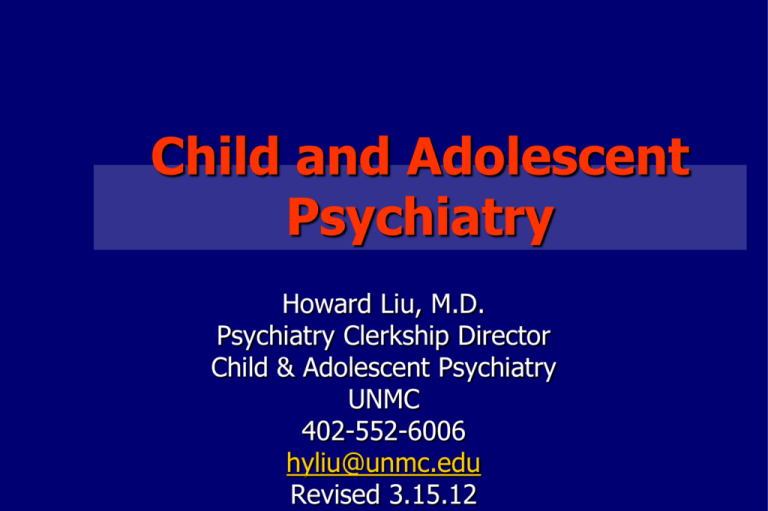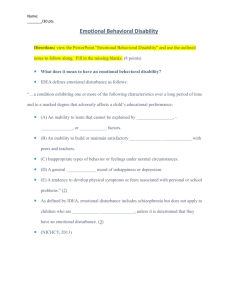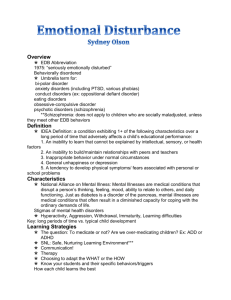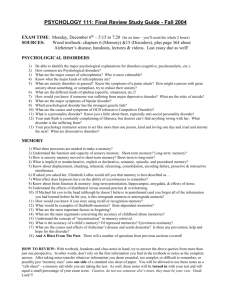Attention Deficit Hyperactivity Disorder
advertisement

Child and Adolescent Psychiatry Howard Liu, M.D. Psychiatry Clerkship Director Child & Adolescent Psychiatry UNMC 402-552-6006 hyliu@unmc.edu Revised 3.15.12 Normal Development Goals / Objectives • Review common diagnoses in pediatric mental health • Recognize epidemiology of major disorders • Recall first line treatment guidelines What will we cover? • • • • • • ADHD Pediatric Bipolar Disorder Anxiety Disorders Autism Eating disorders Substance abuse Fred Rogers • “Play is often talked about as if it were a relief from serious learning. But for children play is serious learning. Play is really the work of childhood.” Child Psychiatry Interview Pearls • Manage the room • Ask intimate questions privately • Be able to “surf” from shallow to deep • Start with social history • Safety is #1 priority ADHD Pop Quiz: ADHD According to the largest study of ADHD to date (the MTA trial), which was the most effective treatment for ADHD in kids after 1 year? A. Stimulant medication B. Behavioral therapy C. School intervention D. Stimulant + Behavioral therapy E. Low sugar diet Elementary School child with ADHD Epidemiology of ADHD in Children • Prevalence is ~ 9.5% of children, • 2/3 treated • Males > Female by 4:1 • Life course – Hyperactivity , Inattention persists • High comorbidity (2/3) – ODD, learning disorder, smoking, etc. CDC National Survey Children’s Health 2007-2008 – 70,000 parents Practice Parameter for the Assessment & Treatment of Children and Adolescents with Attention-Deficit/Hyperactivity Disorder. JAACAP 2007;46(7): 894-921 Diagnostic Criteria for ADHD (DSM-IV) • Must occur before age 7 years • Present for at least 6 months • Causes impairment in at least 2 settings • Meets 6 of 9 symptoms of inattention AND/OR • 6 of 9 symptoms of hyperactivity/impulsivity Diagnosis: Inattentive Subtype • • • • • • • • • Careless mistakes in schoolwork Poor attention in tasks or play Doesn’t listen when spoken to directly Fails to finish things (not oppositional or unable) Difficulty organizing Avoids/dislikes tasks requiring focusing Loses necessary items Distracted by extraneous stimuli Forgetful in daily activities Diagnosis: Hyperactive-Impulsive • • • • • • • • • Fidgets with hands/feet or squirms in seat Often leaves seat when inappropriate Runs about or climbs excessively when inappropriate Difficulty playing quietly Often “on the go” or acts as if “driven by a motor” Often talks excessively Blurts answers before question completed Difficulty awaiting turn Often interrupts or intrudes on others Treatments • Stimulant medications – 1st line (MTA) • Alternative non-stimulant medications • Psychoeducation • Community support • Behavioral interventions • School interventions Stimulant Medications: Efficacy • One of the most robust treatments in psychiatry • 70% of children with ADHD will respond to any one of the stimulants, all generally equal efficacy • An additional 20% will respond to the next one attempted • If the 1st and 2nd choices fail, check for wrong diagnosis and/or comorbidity Medical Issues • Growth: Faraone meta-analysis: – after 2-3 years on stimulants, kids were 1-2.5 cm shorter – Growth rate increases when stimulants stopped • Cardiac Risk – AHA: 1999 guidelines – no routine EKG – AHA: 2008 guidelines – ‘‘...it is reasonable for a physician to consider obtaining an ECG as part of the evaluation of children being considered for stimulant drug therapy, but this should be at the physician’s judgment, and it is not mandatory to obtain one” Bipolar disorder Pop Quiz: Bipolar A 14 year old girl is being treated for pediatric bipolar disorder, when she develops breast tenderness and galactorrhea. Which medication is she most likely taking? A.Carbamazepine B.Risperidone C.Lithium D.Valproic Acid E.Topiramate Diagnosis • Mania: – – – – – – – – Mood + 3 or 4 symptoms D - Distractibility I – Indiscretion (pleasurable activities) G – Grandiosity F – Flight of Ideas A – Activity increases S – Sleep deficit T – Talkativeness (pressured) • Developmental symptoms Faust, DS et al. Diagnosis and Management of Childhood BPD in the Primary Care Setting. Clinical Pediatrics 2006;Vol. 45(9): 801-808. FDA-Indicated Medications for PBD • Approved down to age 12 years for acute mania and • • maintenance therapy – Lithium: grandfathered in based on adult literature Approved only for acute treatment of manic/mixed episodes in children aged 10-17 years – Risperidone: 2007 – Aripiprazole: 2008 – Quetiapine: 2008 Approval in process – Olanzapine – Ziprasidone Anxiety Disorders 9 / 11 Attack Common Anxiety Disorders • Separation anxiety – Anxiety about separation from loved one – School refusal, somatic complaints – Risk factor panic disorder, agoraphobia • PTSD – Preschool alternative criteria: less play • OCD • Panic disorder • Generalized anxiety disorder • Specific phobia / Social phobia Treatment • CBT – 1st line, often in combo with medication – Exposure & response prevention • Medications – OCD: SSRI (POTS), clomipramine, augmentation – PTSD: SSRI, SGA (hyperarousal) – Panic / Separation anxiety / Social phobia / GAD : • SSRI (RUPP study fluvoxamine) • Pearl: for anxiety, always use CBT + SSRI PERVASIVE DEVELOPMENTAL DISORDERS Asperger’s Video Pop Quiz: Autistic savants Kim Peek was the mega savant that inspired “Rain Man.” What is his prodigious skill? A. Near perfect recall of 12,000 books B. Ability to hear any song and reproduce it on the piano C. Ability to sculpt a perfect replica of any animal he sees D. Recitation of Pi from memory to 22,514 digits Pervasive Developmental Disorders • Definition: – Group of psychiatric conditions in which expected social skills, language development, and behavioral repertoire either don’t develop or are lost in early childhood • • • • Early in life (by age 2) Cause persistent dysfunction Often associated with mental retardation (50%) Spectrum of severity Diagnosis • History – early development, age of onset, family and medical history – AAP 2007: screen all kids 18 months, age 2 • Developmental & psychological assessment – – – – Intelligence, learning Communication – language, nonverbal Adaptive behavior – generalize skills to real world OT / PT as needed • Psychiatric exam – Social relatedness, behavior, language, play skills • Medical – genetics, seizures, hearing, etc. Epidemiology • Autistic Disorder – Prevalence: 2.5 to 72 per 10,000 children – Distributed equally among all socioeconomic levels – Male to female ratio 3:1 – Genetic cause – Debunked thimerosol, MMR vaccine theory – Lifetime cost of care: $3 million • Asperger’s disorder – Prevalence: 4.3 per 10,000 – Male to female ratio 10:1 Autistic disorder • 6 items from 3 categories – Category 1: Social impairment • Nonverbal impairment (eye contact ,facial expression, posture, etc.) • Peer relationships (not same age kids, often younger) • Lack of sharing interests with others • Lack of social or emotional reciprocity – Category 2: Communication – language, speech – Category 3: Restricted patterns of behavior, interest, activities • intense interest 1 area, rigid, flapping hands, parts Asperger’s disorder – like “WALL-E” • Social impairment – but they want friends • Repetitive patterns of behavior – Star Wars, machines, World of Warcraft, etc. • NO language delay – often advanced speech – “Little Professor” • “High functioning autism” – normal to high normal intelligence Other PDD Disorders • Rett’s – Girls > boys (boys often die in infancy) – Normal prenatal & perinatal – Head growth decelerates, 5-48 mos., usually before 1 year old – Loss of abilities, MR, language – Motor deterioration, sudden death • Childhood Disintegrative – Normal development x 2 years – Loss of prior skills – language, social skills, bowel/bladder, play, motor skills Autistic Disorder Treatment • No cure for autistic disorder • Primary goals – promote social and communication skills – reduce maladaptive behaviors – alleviate family stress • Best interventions are educational and behavioral – Applied Behavior Analysis (ABA), Early Intervention – Evidence for efficacy in increasing IQ (Early Start Denver Model) • Pharmacotherapy to target specific symptoms: – Antipsychotics, stimulants, SSRI’s – “Start low, go slow” Eating Disorders Pop Quiz: Eating Disorders What is the % body weight below which one qualifies for anorexia nervosa? A. 90% B. 85% C. 80% D. 75% E. 70% Anorexia Nervosa • DSM – Body weight < 85% expected or failure to gain expected weight – Intense fear of gaining weight – Denial, distorted body image – Amenorrhea (3 consecutive cycles lost) • Clinical – Often high achievers, athletes – Very rigid Bulimia nervosa • DSM – Recurrent binges (lack of control, greater portion) – Recurrent purging (vomiting, laxatives, fasting, excessive exercise) – Binging and purging occur at least twice weekly for 3 months – Self image is unduly influenced by weight/shape – Does not occur during episodes of anorexia nervosa Treatment • Anorexia – – – – Highest mortality rate of all mental illness 5-10% die within 10 years, 18-20% within 20 years Recovery: 1/4 get better, 1/4 worse, 1/2 partial recovery Team approach: • Therapy, pediatrician, residential treatment • Lack of resources • Bulimia – Best evidence for CBT – SSRI is helpful Substance Abuse Teen drinking Pop Quiz: Substance abuse Which teen movie stars a celebrity who has NOT been convicted of a DUI? A. Transformers B. Mean Girls C. Braveheart D. House of Wax E. Superbad Epidemiology • Monitoring the Future 2008 Survey - 46,000 8th, 10th, 12th graders – NIDA, U of Michigan – Any drug use: lifetime 20% 8th grade, 47% seniors – Declining: Cigarettes, stimulants, alcohol – Steady: Marijuana – Increasing: prescription pills • Almost 10% of seniors had used vicodin in the past year! Teen Substance Abuse • Abuse: 1 or more over 12 months – Fail to meet expectations at work, school, or home – Using when it’s dangerous (driving) – Legal problems that are substance related – Keep using despite repetitive problems – Occurs over 12 month period Abuse vs. Dependence • Abuse: 1 or more over 12 months – Fail to meet expectations at work, school, or home – Using when it’s dangerous (driving) – Legal problems that are substance related – Keep using despite repetitive problems – Occurs over 12 month period Abuse vs. Dependence • Dependence: 3 or more over 12 months – Tolerance – need to use more – Withdrawal – Use larger amount than intended – Desire to cut down – Lots of time spent in obtaining substance – Important social, work, or play activities are given up – Used despite knowledge of having a problem Treatment • Programs • Individual therapy – Motivational interviewing • Medications – Smoking: Wellbutrin, Chantix – Alcohol: Disulfiram, acamprosate – Opiates: suboxone, methadone It is never too late to have a happy childhood Tom Robbins





